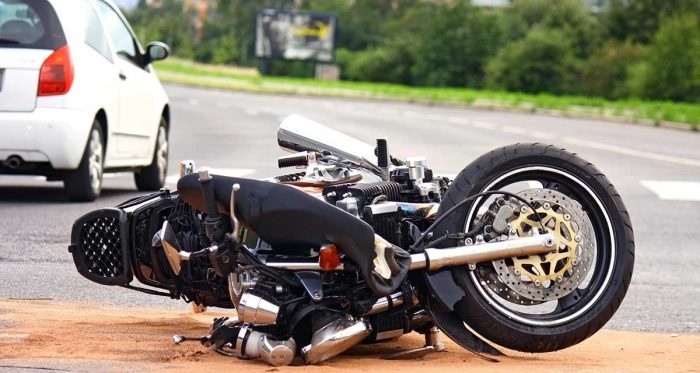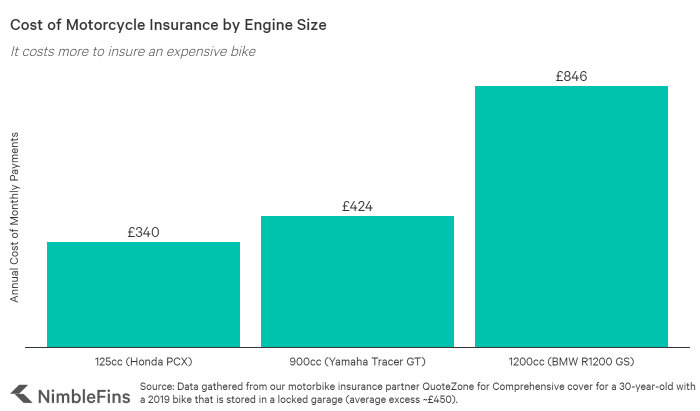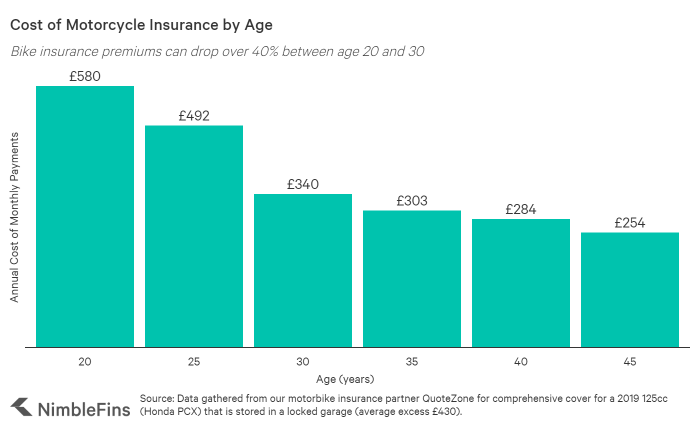The cost of motorbike insurance can vary wildly, depending on a multitude of factors. Understanding these factors is crucial for securing the best possible coverage at a price that fits your budget. This guide delves into the intricacies of motorbike insurance, exploring everything from the influence of your age and riding history to the impact of your bike’s specifications and geographical location. We’ll equip you with the knowledge to navigate the insurance landscape confidently and find a policy that offers the right balance of protection and affordability.
From understanding the different types of coverage available to learning how to secure the best possible rates, we’ll break down the process step-by-step. We’ll also address common misconceptions and provide practical tips to help you save money while ensuring you have adequate protection on the road.
Factors Influencing Motorbike Insurance Costs
Several key factors contribute to the overall cost of motorbike insurance. Understanding these elements allows riders to make informed decisions and potentially secure more favorable rates. These factors interact in complex ways, meaning a small change in one area can significantly impact the final premium.
Rider Age
Insurance companies consider age a significant factor because younger riders statistically have a higher risk of accidents. Inexperience and a tendency towards riskier riding behaviors contribute to this. As riders gain experience and age, their premiums generally decrease, reflecting a lower perceived risk to the insurer. For example, a 20-year-old rider will typically pay significantly more than a 40-year-old rider with a similar riding history. This is because insurance companies use actuarial data showing a higher accident rate for younger riders.
Motorbike Type and Engine Size
The type and engine size of the motorcycle heavily influence insurance costs. High-performance bikes, sports bikes, and motorcycles with larger engine capacities are generally considered higher risk and therefore attract higher premiums. This is due to their potential for higher speeds, greater power, and the increased likelihood of more severe accidents. Conversely, smaller, less powerful motorcycles, such as scooters or smaller-engine capacity bikes, tend to have lower insurance premiums.
Riding History
A rider’s history of accidents and traffic violations directly impacts insurance costs. Insurers carefully review a rider’s driving record. Accidents, speeding tickets, and other violations indicate a higher risk profile, leading to increased premiums. A clean driving record, on the other hand, can result in lower premiums and potentially access to discounts. Multiple accidents or serious violations can even result in policy cancellation or difficulty obtaining insurance.
Geographical Location
The location where a rider lives also plays a role in determining insurance costs. Areas with higher rates of motorcycle theft or accidents will typically have higher insurance premiums. Urban areas often have higher premiums than rural areas due to increased traffic density and the higher likelihood of accidents and theft. This is because insurance companies assess risk based on statistical data for each region.
Levels of Coverage
Insurance policies offer varying levels of coverage, each impacting the premium. Liability-only coverage provides the minimum legal protection, covering damages to others in an accident. Comprehensive coverage provides broader protection, including damage to the motorcycle itself, regardless of fault. Adding optional coverages, such as collision or uninsured/underinsured motorist coverage, will further increase the premium, but offer greater financial protection.
Example Insurance Costs
The following table provides illustrative examples of insurance costs for various rider profiles. These are estimates and actual costs may vary depending on the specific insurer and policy details.
| Rider Age | Riding Experience (Years) | Location (Type) | Annual Premium (Estimate) |
|---|---|---|---|
| 22 | 2 | Urban | $1200 |
| 35 | 10 | Suburban | $800 |
| 45 | 20 | Rural | $600 |
| 28 | 5 | Urban | $900 |
Obtaining Motorbike Insurance Quotes

Securing the best motorbike insurance involves more than just clicking a few buttons. Understanding the process, comparing quotes effectively, and carefully reviewing policy details are crucial steps to ensure you’re adequately protected at a fair price. This section will guide you through obtaining and comparing motorbike insurance quotes, helping you navigate the process with confidence.
Online Quote Acquisition: A Step-by-Step Guide
Acquiring motorbike insurance quotes online is a straightforward process. Most insurers offer user-friendly online platforms designed to simplify the process. The steps generally involve providing key information about yourself, your bike, and your desired coverage.
- Visit insurer websites: Begin by visiting the websites of several reputable motorbike insurance providers. Many comparison websites also exist, allowing you to obtain multiple quotes simultaneously.
- Complete the online application: Each insurer will have an online application form requiring details such as your age, riding experience, bike details (make, model, year), address, and desired coverage levels.
- Review and compare quotes: Once you’ve submitted your information, you’ll receive a quote from each insurer. Take your time to carefully compare the premiums, coverage options, and any exclusions.
- Select your preferred policy: After careful comparison, choose the policy that best suits your needs and budget. Ensure you understand all aspects of the policy before proceeding to purchase.
Comparing Motorbike Insurance Quotes
Comparing quotes requires more than just looking at the price. Consider the level of coverage, any exclusions, and the insurer’s reputation. A cheaper policy with limited coverage might ultimately cost more in the event of an accident.
- Coverage levels: Compare the levels of liability, comprehensive, and collision coverage offered. Consider your risk tolerance and the value of your motorcycle.
- Exclusions: Pay close attention to any exclusions in the policy. Some policies may exclude certain types of damage or riding conditions.
- Insurer reputation: Research the insurer’s claims process and customer service ratings. A reputable insurer will provide efficient and fair claims handling.
- Policy add-ons: Explore available add-ons, such as roadside assistance or replacement parts coverage, and factor their cost and value into your decision.
Policy Details: Understanding Before Purchase
Before committing to a policy, thoroughly review all the policy documents. Understand the terms and conditions, coverage limits, and any exclusions. Don’t hesitate to contact the insurer directly if you have any questions or require clarification. Ignoring this crucial step can lead to unexpected costs or inadequate protection.
Available Discounts
Several discounts can significantly reduce your motorbike insurance premium. These often depend on factors such as your riding history, the type of bike you own, and your overall profile as a policyholder.
- Multi-bike discount: Insuring multiple motorcycles with the same provider often results in a discount.
- Safe rider discount: Maintaining a clean driving record, completing a safety course, or having a long period without accidents can qualify you for a discount.
- Security device discount: Installing anti-theft devices on your motorcycle can reduce your premium, reflecting the reduced risk to the insurer.
- Loyalty discount: Some insurers offer discounts to long-term customers who renew their policies regularly.
Essential Information Checklist
Gathering the necessary information beforehand streamlines the quote acquisition process. Inaccurate or incomplete information can delay the process and may result in inaccurate quotes.
- Personal details: Full name, address, date of birth, driving license number, and contact information.
- Motorcycle details: Make, model, year, engine size, VIN (Vehicle Identification Number), and any modifications.
- Riding history: Years of riding experience, details of any accidents or violations, and your current driving license status.
- Coverage requirements: Determine the level of coverage you require (liability, comprehensive, collision) and any desired add-ons.
- Payment information: Have your payment method ready for when you choose a policy.
Illustrative Examples of Insurance Costs

Understanding the factors influencing motorbike insurance costs is crucial, but seeing them in action through real-world examples provides a clearer picture. The following scenarios illustrate how different rider profiles and bike choices impact premiums. Remember, these are hypothetical examples and actual costs will vary depending on the specific insurer and policy details.
Scenario 1: The Young, Inexperienced Rider
This scenario involves a 20-year-old rider, Alex, living in a major city like London, insuring a 125cc sports bike. Alex has no prior riding experience and is seeking basic liability coverage. The visual representation would show a high bar graph representing the cost, emphasizing the impact of age and inexperience. The higher risk profile associated with young, inexperienced riders translates to a significantly higher premium compared to more experienced riders. We can assume a cost of approximately £500-£700 annually. The location also contributes to the higher cost due to increased accident rates and theft in urban areas. The limited coverage further reduces the overall cost compared to comprehensive coverage.
Scenario 2: The Experienced Rider with a Powerful Machine
Consider Maria, a 45-year-old rider with a clean driving and riding record spanning 20 years. She resides in a rural area and owns a high-powered 1000cc sports touring motorcycle. Maria opts for comprehensive coverage, including roadside assistance and accidental damage. A visual representation would show a moderately high bar graph, reflecting a higher cost than Scenario 1, but considerably lower than the inexperienced rider. The experience factor lowers the risk, while the powerful bike and comprehensive coverage increase the cost. A reasonable estimate for her annual premium would be between £800-£1200. The rural location, statistically having lower accident rates, slightly reduces the overall cost.
Scenario 3: The Mature Rider with a Classic Bike
Finally, let’s look at David, a 60-year-old rider with a long and clean riding history. He lives in a suburban area and owns a classic vintage motorcycle. He chooses a basic liability-only policy. A visual representation would depict a low bar graph, clearly showing the lowest cost among the three scenarios. David’s age, experience, and the lower value/risk associated with a classic bike contribute to a lower premium. His choice of basic liability coverage further minimizes the cost. We can anticipate an annual premium in the range of £300-£500. The suburban location also contributes to a lower cost compared to major cities.
Visual Representation Summary
A simple bar chart would effectively compare the three scenarios. The x-axis would represent the rider (Alex, Maria, David), and the y-axis would show the annual premium. Alex’s bar would be the tallest, reflecting the highest cost, followed by Maria’s, and finally David’s, the shortest, representing the lowest cost. Different colors could be used to represent the different factors contributing to the cost (e.g., age in blue, experience in green, bike type in red, location in yellow, and coverage level in orange). The chart would visually demonstrate how these factors interact to influence the overall insurance cost.
Ending Remarks

Securing affordable and comprehensive motorbike insurance requires careful planning and research. By understanding the key factors influencing costs, diligently comparing quotes, and leveraging available discounts, you can find a policy that provides the necessary coverage without breaking the bank. Remember, the right insurance is an investment in your safety and peace of mind. Use this guide as a resource to make informed decisions and ride with confidence.
Answers to Common Questions
What is the difference between liability and comprehensive motorbike insurance?
Liability insurance covers damages you cause to others or their property. Comprehensive insurance covers damages to your bike, in addition to liability coverage.
How often can I expect my insurance premiums to change?
Premiums are typically reviewed annually, and changes can reflect your driving record, changes in your bike, or adjustments in market rates.
Can I get insurance if I have a poor driving record?
Yes, but it’s likely to be more expensive. Some insurers specialize in high-risk drivers, but you’ll need to be prepared for higher premiums.
What documents do I need to get a motorbike insurance quote?
You’ll generally need your driver’s license, vehicle registration details, and information about your riding history (accidents, violations).